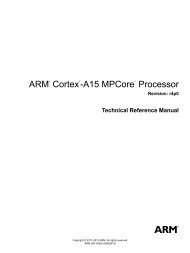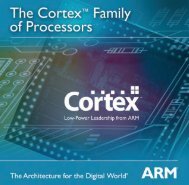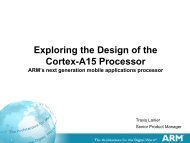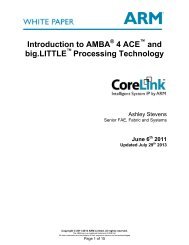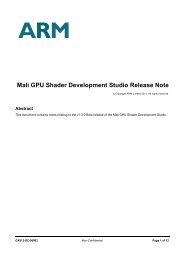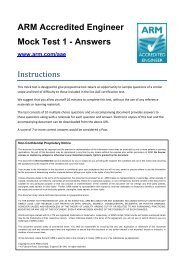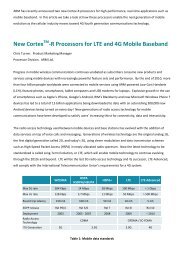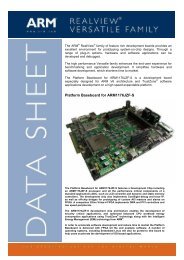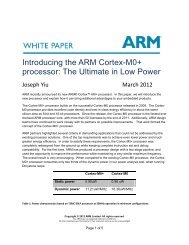32‐Bit Microcontroller Code Size Analysis - Arm
32‐Bit Microcontroller Code Size Analysis - Arm
32‐Bit Microcontroller Code Size Analysis - Arm
Create successful ePaper yourself
Turn your PDF publications into a flip-book with our unique Google optimized e-Paper software.
For an array of integer variables (non‐constant data), changing from an integer to a short integer<br />
might also prevent an increase in memory usage during software porting. Most other data (e.g.<br />
variables) does not require modification.<br />
Floating point functions<br />
Some floating point functions are defined as single precision in 8‐bit or 16‐bit microcontrollers and<br />
are by default defined as double precision in ARM microcontrollers, as we have found out with the<br />
whetstone test analysis. When porting application code from 8‐bit or 16‐bit microcontrollers to an<br />
ARM microcontroller, you might have to adjust math functions to single precision versions and<br />
modify constant definitions to ensure that the program behaves in the same way. For example, in<br />
the whetstone program code, a section of code uses some math functions that are double precision<br />
in ARM compilers:<br />
X=T*atan(T2*sin(X)*cos(X)/(cos(X+Y)+cos(X‐Y)‐1.0));<br />
Y=T*atan(T2*sin(Y)*cos(Y)/(cos(X+Y)+cos(X‐Y)‐1.0));<br />
If we want to use single precision only, the program code has to be changed to<br />
X=T*atanf(T2*sinf(X)*cosf(X)/(cosf(X+Y)+cosf(X‐Y)‐1.0F));<br />
Y=T*atanf(T2*sinf(Y)*cosf(Y)/(cosf(X+Y)+cosf(X‐Y)‐1.0F));<br />
Other constant definitions such as:<br />
/* Module 7: Procedure calls */<br />
X = 1.0;<br />
Y = 1.0;<br />
Z = 1.0;<br />
should to be changed to the following for single precision representation:<br />
/* Module 7: Procedure calls */<br />
X = 1.0F;<br />
Y = 1.0F;<br />
Z = 1.0F;<br />
Define peripherals as data structure<br />
You can also reduce program size by defining registers in peripherals as a data structure. For<br />
example, instead of representing the SysTick timer registers as<br />
#define SYSTICK_CTRL (*((volatile unsigned long *)(0xE000E010)))<br />
#define SYSTICK_LOAD (*((volatile unsigned long *)(0xE000E014)))<br />
#define SYSTICK_VAL (*((volatile unsigned long *)(0xE000E018)))<br />
#define SYSTICK_CALIB (*((volatile unsigned long *)(0xE000E01C)))<br />
ARM <strong>Microcontroller</strong> <strong>Code</strong> <strong>Size</strong> <strong>Analysis</strong> | Recommendations on how to get the smallest<br />
code size with Cortex‐M microcontrollers<br />
15



